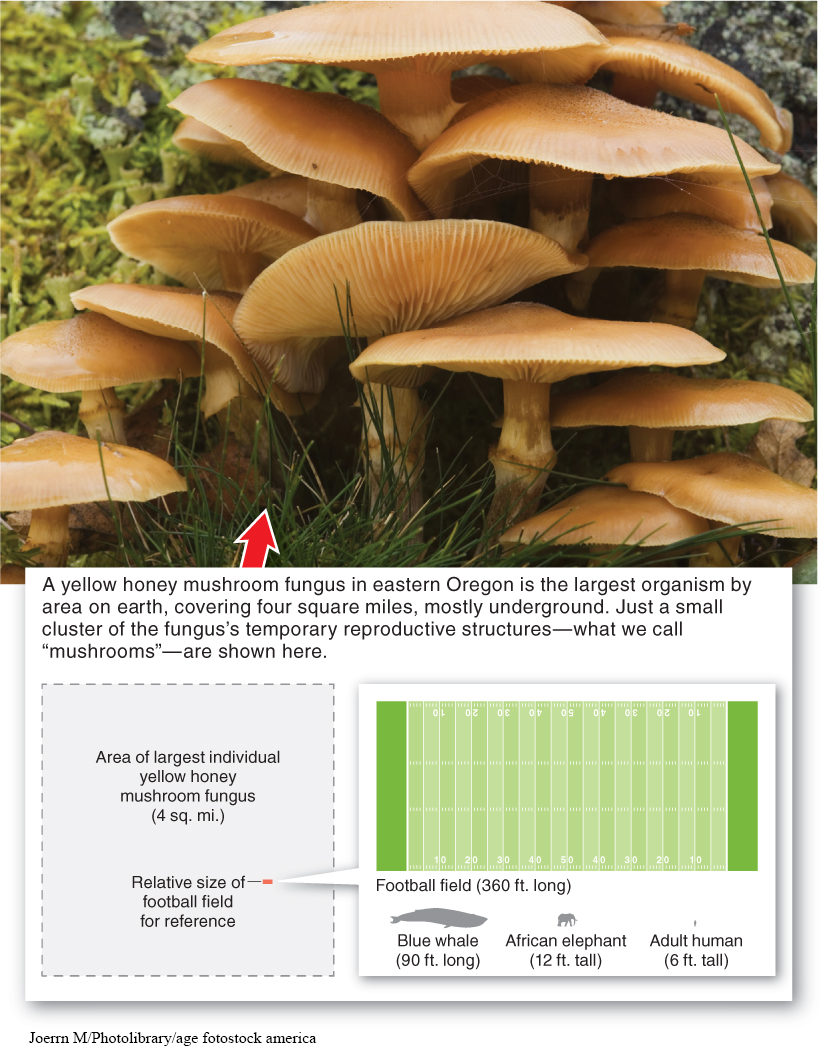
As we’ve seen, most fungi are multicellular and are composed of long strings of barely visible, thread-
The structure that most people associate with fungi is the mushroom. But a mushroom is just a temporary reproductive structure (or “fruiting body”), part of a complex reproductive cycle that includes both sexual and asexual reproduction in some fungi (FIGURE 12-31). This cycle consists of several steps.
- 1. Underground, genetically distinct haploid hyphal cells join together. But their nuclei don’t fuse, so instead of being diploid, they are “dikaryotic,” meaning that each cell in the hypha has two nuclei.
- 2. The dikaryotic mycelium can grow and spread for years.
- 3. At some point, tightly packed dikaryotic hyphae may form a mushroom.
- 4. The haploid nuclei in the dikaryotic hyphae fuse in some cells, putting the mushroom into a diploid state.
- 5. In meiosis, the diploid cells produce huge numbers of haploid spores (up to a billion in a single mushroom!), which are dispersed by wind or water or on the bodies of animals.
- 6. After landing in a hospitable place, the spores grow as haploid hyphae, and the cycle begins anew.
What is the largest living organism in the world?
Fungi have an unusual and effective method of getting nutrition. Unlike humans, they digest their food outside their “body.” While growing underground, hyphae secrete strong enzymes that break down the organic molecules around them, and the hyphae then absorb the nutrient-
521
But huge as it is, the fungus is nonetheless hard to detect, because the mycelium is underground. The fungus appears on the surface only as mushrooms (edible, but not particularly tasty) and as hyphae in dying and dead trees. Indeed, no one even knew that this enormous fungus existed until 2000, when Oregon foresters sought an explanation for an epidemic of dead and dying trees in the Malheur National Forest. (They discovered that the fungus was killing trees by causing their roots to rot.)
Fungi can grow in many different habitats because, as decomposers, all they need for their nutrient supply is some sort of organic material that they can break down. Fungi play an enormously important ecological role in speeding the decay of organic material in forests. They don’t need light, so they can grow underground or inside dead trees and logs.

If you break down the tissues of dead organisms, you are a decomposer, and if you break down the tissues of living organisms, you are a parasite. Just as fungi can live off dying trees, they can also grow in and on people. “Mycosis” is a general term for a disease that is caused by a fungus, such as athlete’s foot, or related fungi that cause jock itch, beard itch, scalp itch, ringworm, and toenail fungus. These fungi get their nutrition by digesting some of the organic molecules of your body! And all of these fungal diseases are quite contagious, because they are spread by spores that can linger on moist surfaces and in clothing, so they tend to be a problem in places like dormitories, gymnasiums, and fitness centers.
Fungi can also thrive in poorly ventilated spaces in buildings (FIGURE 12-33). Molds are multicellular fungi that are responsible for many unpleasant effects. People living or working in a “sick building” can experience burning or watering eyes, a runny nose, and itchy skin—

It wouldn’t be fair to mention so many undesirable effects of fungi without describing some of the many fungi that are beneficial to humans, particularly one that has benefited millions of humans: the fungus that produces penicillin. Alexander Fleming was a researcher studying bacteria. In 1928, just prior to taking a month-
522
Many mushrooms are gastronomic delicacies, and commercially grown portobello and shiitake mushrooms, for example, command high prices. Truffles—
TAKE-HOME MESSAGE MESSAGE 12.14
Fungi are decomposers, and all they need to thrive is organic material to consume and a moist environment so their hyphae don’t dry out. Fungi have complex life cycles, with both sexual and asexual phases, and the parts of a fungus that are most often visible are its temporary spore-
Fungi are important decomposers that break down various organic materials. How is this accomplished?
Fungi digest their food outside of their “bodies” by secreting strong enzymes into their environment. These enzymes break down these organic molecules, which are absorbed into the fungal hyphae.